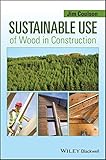Sustainable use of wood in construction / Jim Coulson.
By: Coulson, Jim (James C.) [author.]
Publisher: Chichester, West Sussex, United Kingdom : Wiley Blackwell, 2014Description: xix, 192 pages ; 23 cmContent type: text Media type: unmediated Carrier type: volumeISBN: 9781118539668 (paperback)Subject(s): Building, Wooden | Sustainable construction | Construction industry -- Waste minimization | ARCHITECTURE / Sustainability & Green DesignAdditional physical formats: Online version:: Sustainable use of wood in constructionDDC classification: 691/.10286 LOC classification: TH1101 | .C664 2014Other classification: ARC018000 Online resources: Cover image| Item type | Current location | Home library | Call number | Copy number | Status | Date due | Barcode | Item holds |
|---|---|---|---|---|---|---|---|---|
| Circulation | Sibalom | Sibalom Circulation | 691.10286 C85518 2014 (Browse shelf) | 1 | Available | UAMAIN 11444 |
Browsing Sibalom Shelves , Shelving location: Circulation Close shelf browser

|
No cover image available |

|

|
No cover image available | No cover image available | No cover image available | ||
| 691 B34 2000 The BDA guide to successful brickwork / | 691 H93 1979 Formwork for concrete / | 691 l9915 2014 Materials for architects and builders / | 691.10286 C85518 2014 Sustainable use of wood in construction / | 692 In8d 1976 Dwelling construction under the uniform building code. | 692 In8d 1976 Dwelling construction under the uniform building code. | 692 Ze3b 1975 Builder's guide to contracting / |
Includes index.
"There is a great deal of innovation in the use of wood in construction, from impressive modern buildings to new construction products that reduce build times and improve building performance. As a renewable resource with proven low embodied energy, wood is both an environmentally responsible and a highly practical choice as a construction material. However, forest management practices vary throughout the world: some are highly effective in delivering a sustainable, long term supply of timber; whereas others are less so, and could result in forest depletion and significant environmental degradation. Against this background, a number of certification schemes have been developed that seek to ensure that all timber is harvested from sources that are at least legally-sourced, and at best, sustainably managed. Sustainable Use of Wood in Construction explains how and why wood may be grown sustainably, and how this versatile material can be specified and - most importantly - sourced, for use in the construction industry. It explains the modern regulatory framework within Europe that seeks to eliminate the use of illegally-harvested wood, and it shows how to ensure that everyone who sells or uses wood for construction is following the rules. Finally, the book explains how, at the end of its first use in construction, wood can be recycled, by reprocessing into another wood-based construction material, or by using it as biomass. "-- Provided by publisher.
Machine generated contents note: Preface Acknowledgements 1 Some Things You Should Know About Wood, Trees and Forests 1.1 Some basic information on how trees grow 1.2 Basic tree types - softwoods and hardwoods 1.3 The properties of timbers 1.4 Different forests and tree types 1.5 Rate of growth 1.6 Natural forests 1.7 Managed forests: Conifers 1.8 Managed forests: Broadleaves 2 The Concept of Being 'Sustainable' 2.1 Being sustainable: A definition and a target 2.2 What can we do to help? 2.3 Using the forest resource: The economic argument 2.4 Legal harvesting 2.5 The Timber Trade Federation: Introducing its responsible purchasing policy 3 Voluntary Timber Certification Schemes 3.1 Some further details on the RPP 3.2 Checking legality - I: The Corruption Perceptions Index (CPI) 3.3 Checking legality - II: FLEGT 3.4 Going beyond FLEGT: MYTLAS 3.5 Checking legality - III: Other 'legality' certification schemes 3.6 Checking sustainability: Chain of Custody Certification 3.7 FSC and PEFC as Chain of Custody Certifiers 3.8 Other Chain of Custody Certification bodies 3.9 UKWAS 3.10 Third-party assurance 3.11 How Chain of Custody schemes operate 4 The UK Government and European Regulations: Legally Trading in World Timbers 4.1 Checking up on the checkers: The role of CPET 4.2 CPET's help with legality and sustainability requirements 4.3 Legality and sustainability: The UK government's definitions 4.4 Legal timber sources - the UK government's definition 4.5 Sustainable timber sources - the UK government's definition 4.6 Category A and Category B - 'Proof of Compliance' 4.7 Current and future supplies of certified timber 4.8 The EUTR: Europe's new and compulsory 'timber legality scheme' 4.9 The meaning of 'due diligence' 4.10 Satisfying the EUTR 4.11 Who actually needs to obey the EUTR? 4.12 The 'first placer on the market' 4.13 CE marking and the CPR 4.14 CITES: What exactly is it? 5 Specifying Sustainable Timber for any Project: Some Important Dos and Don'ts; With a Bit More About Wood 5.1 Using wood in a sustainable way 5.2 The government's Timber Procurement Policy (TPP): A brief reminder 5.3 Certificates 5.4 What if I can't get the timber I want? 5.5 The use of recycled timber 5.6 Insisting on a particular Chain of Custody 'brand' for your certified timber 5.7 Deciding which wood to use 5.8 Some of wood's other characteristics 6 Some Principal Softwoods Used in Construction in the UK: With Their Main Properties and Sustainability Credentials 7 A Selection of Hardwoods Used in the UK: With Their Main Properties and Sustainability Credentials 8 Re-use of Timber and Wood Products: The Carbon Cycle, End of Life Disposal and Biomass 8.1 The true 'carbon cycle' 8.2 End of life disposal of timber and wood-based products 8.3 Recycled timber 8.4 Disposal of timber in landfill 8.5 Burning wood: Fossil fuels versus biomass 8.6 Biomass 9 Energy Considerations and Construction Materials 9.1 Embodied energy 9.2 Cradle to grave analysis 9.3 Cradle to cradle 9.4 BREEAM Appendix 1 Terms, Abbreviations and Acronyms Used in this Book Appendix 2 Timber and Wood Products: Some Helpful Organisations Index .

There are no comments for this item.